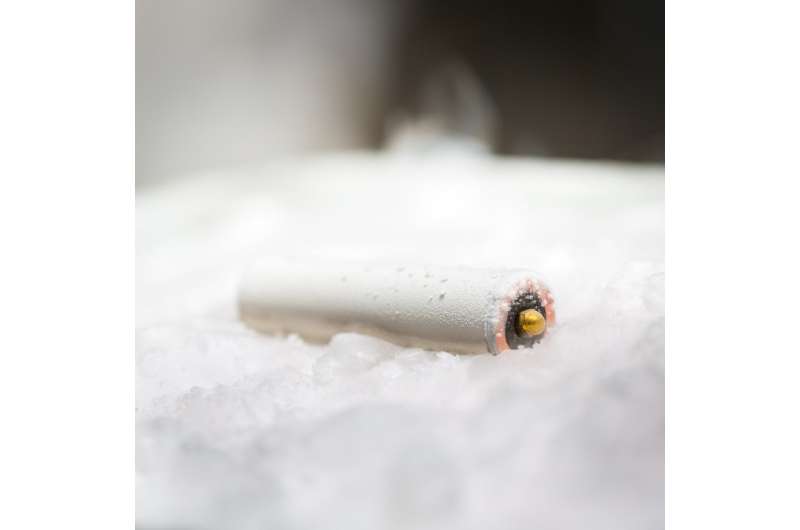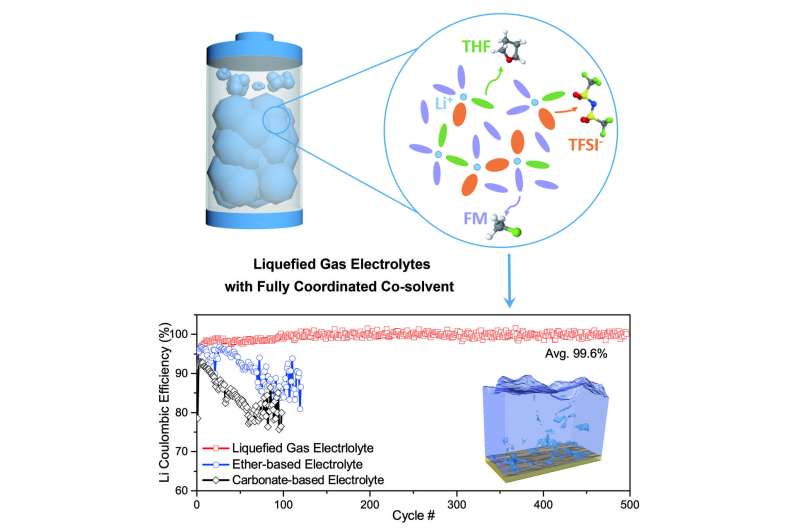New twist in the race to replace the graphite anode for better rechargeable batteries

Improvements to a class of battery electrolyte first introduced in 2017—liquefied gas electrolytes—could pave the way to a high-impact and long-sought advance for rechargeable batteries: replacing the graphite anode with a lithium-metal anode.
The research, published July 1, 2019 by the journal Joule, builds on innovations first reported in Science in 2017 by the same research group at the University of California San Diego and the university spinout South 8 Technologies.
Finding cost-effective ways to replace the graphite anode in commercial lithium-ion batteries is of great interest because it could lead to lighter batteries capable of storing more charge, via a 50 percent increase in energy density at the cell level. The increased energy density would come from a combination of factors including the lithium-metal anode's high specific capacity, low electrochemical potential, and light weight (low density).
As a result, switching to lithium-metal anodes would significantly extend the range of electric vehicles and lower the cost of batteries used for grid storage, explained UC San Diego nanoengineering professor Shirley Meng, a corresponding author on the new paper in Joule.
However, making the switch comes with technical challenges. The main hurdle is that lithium metal anodes are not compatible with conventional electrolytes. Two long-standing problems arise when these anodes are paired with conventional electrolytes: low cycling efficiency and dendrite growth.
So Meng and colleagues' approach was to switch to a more compatible electrolyte, called liquefied gas electrolytes.
Liquefied gas electrolytes in action
One of the tantalizing aspects of these liquefied gas electrolytes is that they function both at room temperature and at extremely low temperatures, down to minus 60 C. These electrolytes are made from liquefied gas solvents—gases that are liquefied under moderate pressures—which are far more resistant to freezing than standard liquid electrolytes.

In the 2019 paper in Joule, the researchers report on how, through both experimental and computational studies, they improve their understanding on some of the shortcomings of the liquefied gas electrolyte chemistry. With this knowledge, they were able to tailor their liquefied gas electrolytes for improved performance in key metrics for lithium-metal anodes, both at room temperature and minus 60 C.
In lithium-metal half-cell tests, the team reports that the anode's cycling efficiency (Coulombic efficiency) was 99.6 percent for 500 charge cycles at room temperature. This is up from the 97.5 percent cycling efficiency reported in the 2017 Science paper, and an 85 percent cycling efficiency for lithium metal anodes with a conventional (liquid) electrolyte.
At minus 60 C, the team demonstrated lithium-metal anode cycling efficiency of 98.4 percent. In contrast, most of conventional electrolytes fail to work below minus 20 C.
The UC San Diego team's simulation and characterization tools, many developed in the Laboratory for Energy Storage and Conversion led by Shirley Meng, allow the researchers to explain why lithium metal anodes perform better with liquefied gas electrolytes. At least part of the answer has to do with how the lithium particles deposit on the metal anode surface.
The researchers report the smooth and compact deposition of lithium particles on lithium-metal anodes when liquefied gas electrolytes are used. In contrast, when conventional electrolytes are used, needle-like dendrites form on the lithium metal anode. These dendrites can degrade the efficiency, cause short circuits, and lead to serious safety threats.
One measure of how densely lithium particles deposit on anode surfaces is porosity. The lower the porosity the better. The research team reports in Joule that porosity of lithium particle deposition on a metal anode is 0.90 percent at room temperature using liquefied gas electrolytes at room temperature. The porosity in the presence of conventional electrolytes jumps to 16.8 percent.
The race for the right electrolyte
There is currently a big push to find or improve electrolytes that are compatible with the lithium metal anode and are competitive in terms of cost, safety, and temperature range. Research groups have mainly been looking at highly-concentrated solvents (liquid) or solid-state electrolytes, but there is currently no silver bullet.
"As part of the battery research community, I am confident that we are going to develop the electrolytes that we need for lithium-metal anodes. I hope that this research inspires more research groups to take a serious look at liquefied gas electrolytes," said Meng.
Meng is also the corresponding author on a related article in the May 2019 issue of Trends in Chemistry "Key Issues in Hindering a Practical Lithium-Metal Anode."
More information: High Efficiency Lithium Metal Anode Enabled by Liquefied Gas Electrolytes, Joule (2019).
Provided by University of California - San Diego


















